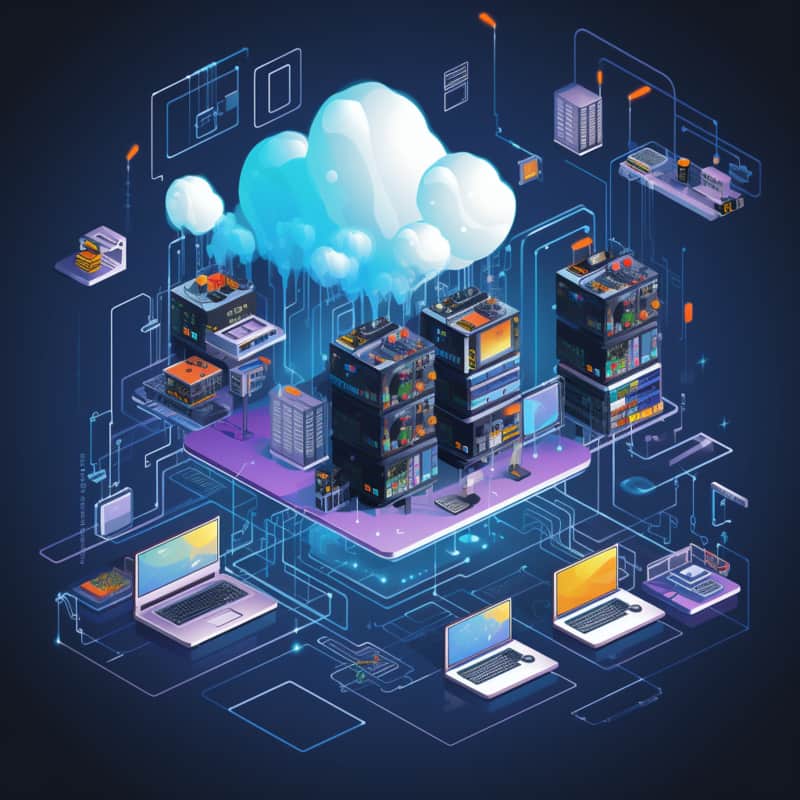AWS VPC Interview Questions
VPC (Virtual Private Cloud) is an essential AWS feature that enables customers to establish virtual networks within the cloud. VPC protects and isolates EC2 instances, databases and load balancers while protecting from attack by outside forces such as hackers.
This blog covers all essential subjects from basics to complex network configurations, helping you confidently prepare for an AWS VPC interview!
Let’s do this together!

1. What is a VPC (Virtual Private Cloud), and what does it allow you to do?
A VPC is a virtual network dedicated to your AWS account. It gives you complete control over what you do with defining your site, including specifying destinations and targets for specific networks.
2. What is the purpose of attaching an internet gateway to a VPC?
An internet gateway is attached to a VPC to allow traffic out to and in from the internet.
3. What is IP addressing, and what is the purpose of domain name resolution?
IP addressing, specifically IP version 4, is a public IP address computers use to communicate with each other.
Domain name resolution is used to resolve a name into an IP address, which is less easy to remember but is how computers communicate.
4. What are VPC endpoints, and what do they allow you to do?
VPC endpoints allow you to connect private IP addresses to public services on AWS.
5. What is the structure of an IP address, and how is it represented?
The structure of an IP address is represented by dotted decimal notation, which is a binary object. An IP address is a sequence of eight values, either one or zero.
6. What are sub-net masks, and how are they used in IP addresses?
Subnet masks determine which bit is the network and which portion is the host ID. Every IP address has a network ID and a host ID.
A 24-bit sub-net mask represents the network ID, with the first three octets representing the network ID and the last octet representing the host ID.
7. What is the difference between a class A, B, and C subnet mask?
Class A allows up to 126 networks with many hosts, while class B has a 16-bit sub-net mask, reducing usable addresses per network to 65,536. Class C has a 24-bit sub-net mask, increasing the number of networks but reducing the number of addresses available per network
8. What is the destination IP in the firewall rule table?
The destination IP in the firewall rule table is the client.
9. What are private IP address ranges, and what is their purpose?
Private IP address ranges are reserved for personal use within a company, not on the public internet. They optimise IP space by varying the length of subnet masks and ensuring that data sent out of a subnet goes to another subnet or the internet.
10. What is classless inter-domain routing (CIDR), and how does it work?
CIDR is a method of routing that optimises the number of networks and hosts needed. It uses variable-length sub-net masks to assign addresses to subnets.
11. What is the difference between an egress-only and an internet gateway?
An egress-only internet gateway is used when using the IPV6 protocol, allowing traffic outbound only, while an internet gateway for IPV version 4 allows both egress and ingress traffic.
12. What are the components of a VPC, and what do they do?
The virtual private gateway and the customer gateway are the components of a VPC that create virtual private network VPN connections to company offices or data centres.
13. What is a Virtual Private computer centre (VPC), and how is it used?
A VPC is a location where resources like Amazon EC2 instances are launched. To create a VPC, you must specify the side of the block and the overall block of addresses.
14. What are subnets in a VPC, and how are they used?
Each subnet is always within one AZ and can span AZs, but you can create multiple subnets in an availability zone. Five subnets per region can be made by default, but you can extend this if you submit a request.
15. What is VPC pairing, and how is it used?
VPC pairing allows for direct routing between VPCs using private IP addresses, avoiding overlapping sides of blocks.

AWS VPC Training

The VPC wizard is a valuable tool that helps plan out your side of blocks in subnets based on the number of networks, subnets, or hosts per network.
17. What pre-configured options does the VPC wizard offer?
The VPC wizard offers four pre-configured options: a VPC with a single public subnet, a VPC with public and private subnets, a VPC with public and private subnets and hardware VPN access, and a VPC with a private subnet only and hardware VPN access.
18. What is the source IP in the firewall rule table?
The source IP in the firewall rule table is the web server.
19. What are allow and deny rules in network ACLs?
Allow and deny rules in network ACLs are used to filter network traffic. Allow rules allow traffic to pass through, while deny rules block traffic from passing through.
20. What is the purpose of creating a custom VPC with public subnets, private subnets, two route tables, and an internet gateway?
Creating a custom VPC with public subnets, private subnets, two route tables, and an internet gateway is crucial for AWS professionals and essential for various AWS exams and career paths.
21. What is the purpose of the AWS CLI run instances command?
The AWS CLI run instances command launches EC2 instances in the specified region.
22. What is the purpose of specifying an image ID, AMI ID, security group ID, subnet ID, and user data in the AWS CLI run instances command?
Specifying an image ID, AMI ID, security group ID, subnet ID, and user data in the AWS CLI run instances command ensures that the EC2 instance is configured correctly and launched.
23. What is the purpose of the user data file in the AWS CLI run instances command?
The user data file is used to run a web server and create variables from metadata, grabbing the subnet ID.
24. What is the purpose of overriding the subnet ID in the VPC management console?
Overriding the subnet ID in the VPC management console allows for the launch of EC2 instances into different subnets.
25. What is the difference between stateful and state-less firewalls?
A stateful firewall is a firewall that keeps track of the state of network connections, allowing it to filter traffic based on the context of the connection.
A state-less firewall is a firewall that does not keep track of the state of network connections and filters traffic based solely on the source and destination addresses and ports.
26. What is the purpose of security groups and network access control lists (ACLs) in an AWS environment?
Security groups and network access control lists (ACLs) control network traffic in an AWS environment.
27. What is a firewall rule table?
A firewall rule table is a database that contains the rules for filtering network traffic. It is essential for allowing HTTP traffic from a source IP to a destination IP.
28. What are the differences between complete and stateless firewalls and security groups?
Complete and stateless firewalls allow return traffic automatically, while security groups only require a rule for inbound traffic from any client and port.
The return traffic is automatically allowed, and the firewall treats it separately. Network ACLs need both inbound and outbound rules, and understanding these differences is crucial when configuring network ACLs.
29. What is a security group rule set?
A security group rule set is a set of rules that control access to a network or application layer. It has separate rules for inbound and outbound traffic.
30. What is the purpose of copying the user data file to the Amazon VPC directory and specifying it in the AWS CLI run instances command?
Copying the user data file to the Amazon VPC directory and specifying it in the AWS CLI run instances command ensures that the EC2 instance is configured correctly and launched.
31. What are the inbound and outbound rules in network ACLs?
Inbound and outbound rules in network ACLs determine whether network traffic is allowed or denied.
32. Can network ACLs have an explicit deny?
Yes, network ACLs can have an explicit deny rule.

AWS VPC Online Training

33. What is the purpose of Direct Connect?
Direct Connect avoids the internet by using private connections to your data centre or office.
34. How are rules processed in network ACLs?
Rules in network ACLs are processed in order, and once an allow or deny rule is reached, processing stops.
35. What is the purpose of configuring a VPN and a web service?
The purpose of configuring a VPN and web service is to test the access to security groups and network ACLs on the internet.
36. What is the process of testing the access to a security group on the front end?
Testing the access to a security group on the front end involves creating a new security group, a private app, and assigning it to an instance.

Take our multiple-choice quiz in this blog post to determine how much you know and if you’ve got what it takes.
1. What notation represents the structure of an IPv4 address?
a) Octal representation
b) Binary sequence format
c) Hexadecimal code
d)
2. In an IP address, what does the subnet mask determine?
a)
b) Speed of the network connection
c) Encryption level of data transmission
d) Number of available IP addresses
3. What subnet mask is used in AWS to represent the 192.168.0.0 network?
a) 8-bit
b) 32-bit
c)
d) 16-bit
4. With classless inter-domain routing (CIDR), what does variable-length subnet masking allow?
a)
b) Preserve the binary sequence
c) Fix the length of an IP address
d) Extend the network ID across multiple regions
5. What is the role of an internet gateway in a VPC?
a) Encrypt data
b) Define subnet masks
c) Allocate IP addresses to instances
d)
6. What is a VPC peering connection used for?
a) Increase website speed
b) Connect to the internet
c) Diversify IP addressing
d)
7. How many potential hosts can a subnet have with a 24-bit subnet mask?
a) 65,534
b) 16,777,216
c)
d) 126
8. Which component connects an AWS environment to an on-premise data centre?
a) Egress-only internet gateway
b) Virtual private network (VPN) connection
c)
d) Internet gateway
9. What is the primary characteristic of a stateful firewall?
a)
b) Operates only on the application layer
c) Requires explicit rules for both inbound and outbound traffic
d) Blocks all traffic by default
This AWS VPC Questions and Answers blog should help you understand AWS VPC as well as prepare you for potential interviews regarding its capabilities.
Organizations can use AWS VPC for efficient, scalable, secure networking by following best practices using its abundant documentation resources available here as this blog.
I hope this interview questions on AWS VPC should help prepare you in advance so you are well prepared!

AWS VPC Course Price


Ankita
Author